#Buddhism in Taxila
Text
Exploring the Ancient Ruins of Taxila in Pakistan
Exploring the Ancient Ruins of Taxila in Pakistan
Taxila, located in the Rawalpindi District of Punjab, Pakistan, is one of the most important archaeological sites of ancient India and remains an incredible glimpse into the life and culture of the ancient civilisation that once thrived in the region.
This ancient city, located on the banks of the River Indus, is one of the most renowned cities of the Indian subcontinent and was, for over 1000…

View On WordPress
#AncientRuins#Antiquities#Architecture#Buddhism#Buddhism in Taxila#CentralAsia#CulturalExperience#CulturalHeritage. Archaeology#Discover#Exploration#GandharaCivilization#GreaterIndia#GreatestScholars#HistoricalSites#History#IndoPak#IndusValley#LandofLegacy#Pakistan#Ruins#SilkRoad#Taxila#TradingPost#Travel#WorldHeritage
0 notes
Photo

Takṣaśilā or Taxila, Gandhara, by Juan de Lara
33 notes
·
View notes
Photo
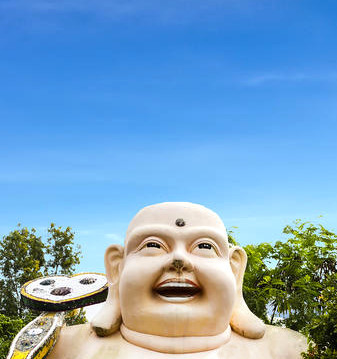
The Quest for Buddhism (60)
The story of the Elder Soreyya (Soreyyatthera-vatthu) - the subject matter of gender and sexuality clues in BCE
There is a famous incident related to Katyayana (Ref) with a double sex change motif, given in Verse 43 of the Dhammapada commentary.
A man named Soreyya was traveling with a friend and happened to see Katyayana adjusting his robes.
Upon seeing his golden complexion, Soreyya began to fantasize that Katyayana should become his wife or that his wife's complexion should be like that of Katyayana. Due to the nature of this thought, he transformed into a woman. He married a wealthy man from Taxila and bore him two sons.
Soreyya later approached Katyayana and explained the situation, apologising for his misconduct in thought. Katyayana accepted his apology, upon which Soreyya regained his male form. He then went forth as a Buddhist monk, and eventually become an arahant.
The truth about thousands of years ago is unknown, whether he really underwent a double sex change, was originally a hermaphrodite, or bisexual, or spoke of homosexuality as a variant.
In view of the negative representation of this anecdote, it is not hard to see it as propaganda.

仏教の探求 (60)
長老ソレイヤの物語 (ソレヤッテラバトゥー)〜紀元前のジェンダーとセクシュアリティの手掛かり
『ダンマパダ(法句経)』の注釈書の第43段に、カーティヤーヤナ(参照)に関連する、二重性転換をモチーフにした有名な話がある。
ソーリーヤという男が友人と旅をしていて、たまたまカーティヤーヤナが衣を整えているのを見かけた。
その金色の顔色を見て、ソーリーヤはカーティヤーヤナが自分の妻になるべきだとか、自分の妻の顔色がカーティヤーヤナのようであるべきだと空想するようになった。この思いのせいで、彼は女性に変身してしまった。彼はタキシラの富豪と結婚し、二人の息子を産んだ。
その後、ソーリーヤはカーティヤーヤナに近づき、事情を説明し、自分の考えの誤りを謝罪した。カーティヤーヤナは彼の謝罪を受け入れ、ソーリーヤは男の姿に戻りった。その後、彼は僧侶として出家し、やがて阿羅漢となった。
彼が本当に二重の性転換をしたのか、元から雌雄同体 (しゆうどうたい)だったのか、同性愛を変形させて語ったのか、数千年前の真実は定かではない。
この逸話をネガティヴに表現されていることから見ても、プロパガンダと思えなくはない。
#Soreyyatthera-vatthu#dhammapada#gender and sexuality#soreyya#katyayana#mahakatyayana#disciple of buddha#buddhism#history#art#philosophy#nature#bce
61 notes
·
View notes
Text
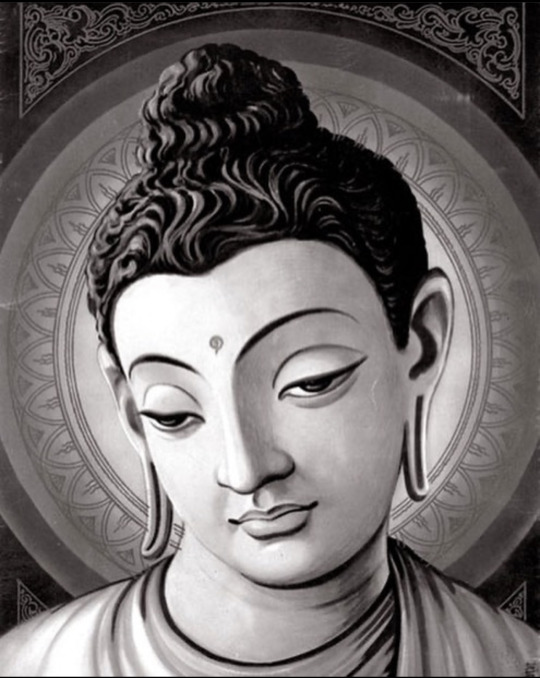
Global Spread of Buddhism - 10
Buddhism in Pakistan
Buddhism was introduced to present day Pakistan in the 3rd century BC, when emperor Ashoka sent Buddhist emissaries to spread Buddhism. During the Gandhara period Buddhism was the prevalent religion with Mahayana and Vajrayana traditions being practised by the majority of the population until the Islam invasions during the 7th century. The Indo-Greek king Menander who ruled from 160 to 130 BC was a Buddhist devotee and a dialogue between him and a Buddhist scholar named Nagasena is recorded in the widely known Buddhist text called Milindapanha. Places like Taxila and Swat valley had been cradles of Buddhism and Gandhara Buddhist art in the past and it is believed that at one time there were 1400 Buddhist monasteries in the Swat valley practising the three Buddhist traditions of Theravada, Mahayana and Vairayana. In 2007, the seven meters tall stone Buddha statue in the Swat valley was attacked and damaged by suspected Taliban extremists. According to the National Database and Registration Authority (NADA), there were only 1492 Pakistani nationals in 2012 who were identified as Buddhist.
Buddhism in Afghanistan
It is widely believed that following the 3rd Buddhist council in India during the 3rd century BC, emperor Ashoka sent Buddhist missionaries to the region now known as Afghanistan to spread the Buddha's teachings. There is also a theory that Buddhism would have already existed there as some Buddhist monks went there to settle down following the 2nd Buddhist council held 100 years following the Buddha's passing away. The ancient kingdom of Gandhara which included Afghanistan was once considered the jewel of Buddhist civilization and Buddhist art and it is believed that the Gandhara artists painted and sculpted Buddha in human form for the first time. Prior to that Buddha was always represented by a symbol or an empty space.
Theravada tradition of Buddhism seems to have existed there first but the Mahayana tradition became the predominant tradition later on.
Buddhism flourished during the Kushan period and the 4th Buddhist council held around 100 CE to promote Mahayana tradition was facilitated by the Kushan ruler Kanishka. By the 4th century CE Bamiyan had one of the biggest Buddhist monastic communities where the two world famous giant standing Buddha statues were carved into a cliff which were to be destroyed by the Taliban in 2001. It is believed that up to 5000 Buddhist monks used to live and meditate in the caves behind the statues.
Valuable articles of Buddhist art as well as Buddhist religious sites were destroyed during the wars and by Islam extremists and remains of Buddhist art, temples, monasteries, stupas and Buddhist relics are still being discovered in several regions of Afghanistan. Buddhism began to decline with the Islam invasions in the 7th century and by the 11th century it was virtually extinct in Afghanistan.
#buddha#buddhist#buddhism#dharma#sangha#mahayana#zen#milarepa#tibetan buddhism#thich nhat hanh#dhammapada#karma#mindfulness#dakini#four noble truths#pure land#equanimity#avalokitesvara#manjushri#bodhisattva#tsongkhapa#padmasambhava#green tara#atisha#amitabha#shantideva#heart sutra#vajrasattva#medicine buddha#meditation
3 notes
·
View notes
Text
The Heliodorus Pillar
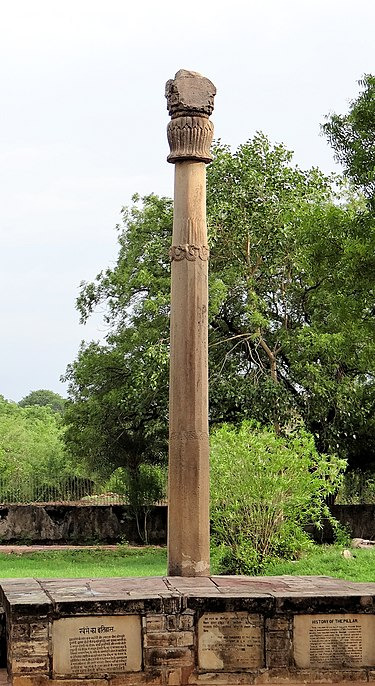
“The Heliodorus pillar is a stone column that was erected around 113 BCE in central India[1] in Besnagar (near Vidisha, Madhya Pradesh). The pillar was called the Garuda-standard by Heliodorus, referring to the deity Garuda. The pillar is commonly named after Heliodorus, who was an ambassador of the Indo-Greek king Antialcidas from Taxila, and was sent to the Indian ruler Bhagabhadra.[2] A dedication written in Brahmi script was inscribed on the pillar, venerating Vāsudeva, the Deva deva the "God of Gods" and the Supreme Deity.[3][4][5][6] The pillar also glorifies the Indian ruler as "Bhagabhadra the savior". The pillar is a stambha which symbolizes joining earth, space and heaven, and is thought to connote the "cosmic axis" and express the cosmic totality of the Deity.[3]
The Heliodorus pillar site is located near the confluence of two rivers, about 60 kilometres (37 mi) northeast from Bhopal, 11 kilometres (6.8 mi) from the Buddhist stupa of Sanchi, and 4 kilometres (2.5 mi) from the Hindu Udayagiri site.[7]
The pillar was discovered by Alexander Cunningham in 1877. Two major archaeological excavations in the 20th-century have revealed the pillar to be a part of an ancient Vāsudeva temple site.[4][8][9] Aside from religious scriptures such as the Bhagavad Gita, the epigraphical inscriptions on the Heliodorus pillar and the Hathibada Ghosundi Inscriptions contain some of the earliest known writings of Vāsudeva-Krishna devotion and early Vaishnavism and are considered the first archeological evidence of its existence.[10][11][12][13][14][6] The pillar is also one of the earliest surviving records of a foreign convert into Vaishnavism.[15][6] Alternatively, making dedications to foreign gods was only a logical practice for the Greeks, intended to appropriate their local power. This cannot be regarded as a "conversion" to Hinduism.[16]”

Main inscription of the Heliodorus pillar, circa 110 BCE
“There are two inscriptions on the pillar. The inscriptions have been analysed by several authors, such as E. J. Rapson,[44] Sukthankar,[27]Richard Salomon,[5] and Shane Wallace.[4]
The text of the inscriptions is in the Brahmi script of the Sunga period, the language is Central-western epigraphic Prakrit, with a few Sanskritized spellings.[5] The first inscription describes the private religious dedication of Heliodorus (Translations: Richard Salomon):[5]
Line 1. This Garuda-standard of Vāsudeva, the god of gods
Line 2. was constructed here by Heliodora (Heliodoros), the Bhagavata,
Line 3. son of Dion, a man of Takhkhasila (Taxila),
Line 4. the Greek ambassador who came from the Great King
Line 5. Amtalikita (Antialkidas) to King
Line 6. Kasiputra Bhagabhadra, the Savior,
Line 7. prospering in (his) fourteenth regnal year.[45]
The second inscription on the pillar, in the same script, recites a verse from the Hindu epic Mahabharata:[22][26]
Line 1. (These?) three steps to immortality, when correctly followed,
Line 2. lead to heaven: control, generosity, and attention.[45]”
Source: https://en.wikipedia.org/wiki/Heliodorus_pillar
This monument is of great importance for many reasons. I see that there is a debate about the conversion or not of Heliodorus to early Vaishnavism. It seems that most Greeks established in India after Alexander converted to or at least have been heavily influenced by Buddhism, but nothing excludes that some among them adopted other forms of Indian religiosity. I remind only that (according to most scholars) the great Indian epic Mahabharata was still in a process of formation in Heliodorus’ time, but also that the use of the term “hinduism” is perhaps rather anachronistic for the same period.
2 notes
·
View notes
Text
UN Resolution 2024
Mrs Sweta Srivastava cares much about SDG 4 Quality Education, Global Goals
Her Declaration:
We, the educators of India, stand united in our commitment to achieve the Sustainable Development Goal 4: Quality Education for all.
We believe that education is the key to unlocking the potential of every child, and the foundation of a prosperous and peaceful society.
We are proud of our rich and diverse history of education, which dates back to ancient times, when gurukuls and ashrams nurtured holistic learning and wisdom.
We are inspired by the legacy of our great universities, such as Nalanda and Taxila, which attracted scholars from across the world and contributed to the advancement of knowledge in various fields.
We are grateful for the influence of Buddhism, Jainism, and Islam, which enriched our educational landscape with spirituality, philosophy, and literature.
We are resilient in the face of challenges, such as invasions, colonialism, and political upheavals, which disrupted our educational institutions and imposed foreign systems and languages.
We are determined to overcome the barriers of poverty, inequality, and discrimination, which prevent millions of children from accessing quality education.
We are innovative in embracing technology, vocational training, and adult education, which enhance the skills and employability of our youth and adults.
We are respectful of our diverse languages and cultures, which reflect our identity and heritage.
We are responsible for ensuring that our education system is inclusive, equitable, and effective, and that it promotes lifelong learning opportunities for all.
We are the agents of change, who can transform our education system and our society for the better.
We are the educators of India, and we pledge to work together to achieve the Global Goal 4: Quality Education for all.
Sweta Sri. The National UN Volunteers-India

0 notes
Text
Tracing the Historical Evolution of Education in Pre-Independent India
India has always been known for its rich history and diverse cultures. Throughout the centuries, education has been an essential aspect of Indian society. This exploration delves into the history of education policies in India, analyzing two distinct epochs - the pre-British era and the British colonial period. The focus of this article is on the pre-British era.
Unraveling the Educational Tapestry
Researching education policies in ancient India is not easy due to the scarcity of literary records. However, insights can be gleaned from literary sources dating back to AD and beyond. Key sources that provide an insight into ancient education include the Rigveda, the Aranyaka, the Upanishads, the epics, and the Puranas.
A Glimpse into Ancient India's Educational Landscape
Ancient India emphasized a holistic approach to education, encouraging students to engage in research, contributing to the growth of knowledge. Education primarily took place in Gurukuls or Gurudhams, unlike today's universities and colleges.
Patronage and Scholarship: Kings and Kingdoms
Powerful kings played a pivotal role in shaping educational policies in ancient India, offering donations and lands to scholars and fostering a thriving educational environment. Two prominent universities, Nalanda and Taxila, stood as bastions of scholarship during this period.
Buddhism vs. Brahmanism: Shaping Educational Ideals
Between 400 BC and 1000 BC, India witnessed a profound intellectual struggle between Buddhism and Brahmanism. Buddhism championed inclusivity and equality, opening doors to knowledge for all castes. Monks resided in Viharas, with Nalanda University emerging as a preeminent center of learning, offering free education and lodging to students. The Brahmanical system of education aimed to make students self-dependent, prioritizing the mastery of ancient texts and self-sufficiency.
Educational Landscape During the Mughal Period
Girls received education at home or from private tutors during the Mughal era. Special arrangements were made for the education of royal ladies, with some princesses attaining distinction as scholars. Notably, the Mughal dynasty witnessed a flourishing period in literature, science, and commerce.
British Colonial Influence: A Shift in Education
Under British colonial rule, education in India underwent significant transformation. Initially, education was limited to reading religious texts in vernacular languages and mastering arithmetic. Higher education introduced subjects such as Sanskrit, Arabic, Persian, law, logic, medicine, and astronomy, drawing upon ancient texts.
Key Milestones in British-Era Education Policy
As the British colonized India, they introduced several key milestones in education policy. The Charter of 1698 marked the first official document addressing education in India, emphasizing the need for English education in order to produce a more obedient and productive population. The Charter Act of 1813 followed suit, allocating funds for the establishment of schools and promoting English education among the Indian elite.
In 1823, the Committee of Public Instruction was formed to further the development of English education in India. However, this committee was met with resistance from Indian reformists, who called for a new form of education that emphasized Indian languages and culture. Raja Ram Mohan Roy was among those who advocated for this new approach, recognizing the need to create a national identity rooted in India's own traditions.
The British responded with William Bentinck's endorsement of Indian language education in 1835. This led to the establishment of vernacular schools throughout India and a renewed emphasis on the study of Indian history and culture.
The East India Company Charter was renewed in 1813, giving the British further authority over Indian education. It was not until 1854, with Charles Wood's Education Dispatch, that a comprehensive education policy was introduced. This document became known as the Magna Carta of English Education in India and focused on establishing a uniform system of education throughout the country.
The Sargent Commission in 1944 marked a significant shift towards post-war education development in India. This commission recognized the need to provide education for all children, regardless of social or economic status.
Despite the efforts of British colonizers, Indian reformists like Raja Ram Mohan Roy continued to push for a new form of education that was rooted in Indian traditions. Their vision played a pivotal role in shaping the future of education in pre-independent India.
In summary, the evolution of education policies in pre-independent India showcases a dynamic journey that spans from ancient traditions to the transformative impact of British colonial rule. The stage was set for an independent India's educational landscape, and the legacy of this era continues to impact education policies in India today.
1 note
·
View note
Text
Ahimsa: Dharma, Defense and Politics
————————————————–
Ahimsa is the other most abused word in Indian politics along with Hindutva. Why is this word being thrown around every other sentence without any context? Why is a protest legitimate only if it is non-violent? Why is the Congress party acting as if it owns the sole patents and copyrights to Ahimsa – choosing to deride protests it wishes and praising others as per its whim? What is the reason and history and has it been beneficial for us as a religion/community/nation?
As per western interpretations – ahimsa has only one meaning of non-violence. Buddhists and Jains also agree to this strict interpretation of Ahimsa- total non-violence and causing no harm to any other living being. M K Gandhi also believed in it and went a bit too far as “intolerant tolerance” [1]. Hinduism itself has no strict definition of ahimsa [2]. Ahimsa in Hinduism is very loosely translated and is different for different roles in society – be it caste, stage of life, personal conduct, the right to defend, righteousness and defense of religion [2]. The Mahabharata, Adi Parva, Manav Parva, Anusasana Parva and Bhagvad Gita have gone into great detail to explain this [2].
अहिंसा परमो धर्मः धर्म हिंसा तथीव च
Ahimsa Paramo Dharma Dharma himsa tathaiva cha
Non-violence is the ultimate dharma. So too is violence in service of Dharma
A brief note is in order here. Dharma here does not mean religion rather duty as per what is right or good for humanity against what is evil and bad.
Is non-violence possible in contexts of nation states? The answer is to the contrary. Many people believe that the advent of Buddhism and by extension the embrace of its strict definition of non-violence resulted in a weak mindset. This may have ultimately caused the downfall of the kingdoms of Taxila, Gandhar and other frontier states in modern day Afghanistan paving the way for further incursions into the Indian heartland by Islamic invaders. In today’s context, is it possible to defend our nation just by diplomacy? Without coercive action against princely states, India could not be the modern nation state it is today. Also, in the very recent past we have seen the numerous fallouts after each diplomatic handshake – Kargil War in 1999, the attack on Parliament in 2001, various bomb blasts across the nation facilitated by cross-border terrorism are some of the few examples. Contrast this with some of the offensive actions taken by Israel since its Independence and we have a result set to compare. Israel is feared by all its neighbors as well as in its extended backyard of the Middle East. India is considered a “soft” nation by almost all countries.
In case of terrorism, Israel has an official policy of not negotiating with terrorists and goes out on dangerous missions such as Operation Entebbe where a hijacked plane and almost all hostages were rescued with minimal casualties [3]; Operation Wrath of God was initiated to eliminate all the members of the Black September group responsible for killing Israeli athletes at the Munich Olympics [4] and Operation Opera was successfully undertaken to bomb Iraq’s nascent nuclear program and facilities [5]. Israel has invaded Lebanon to flush out PLO terrorists and occupied the West Bank and Golan heights as buffer zones. Contrast this with India where we released terrorists in exchange for hostages of the hijacked Indian Airlines flight 814 [6], we hesitate to hang Afzal Guru and Ajmal Kasab in spite of their convictions by the courts and we released captured lands during the 1965 and 1971 wars against Pakistan. The more we compromise and the more we delay action and think non-violence can solve problems, the more we encourage our enemies to be bolder in action.
As far as politics is concerned, I am of the opinion that non-violence does not serve any purpose. The government with all the powers of the judiciary, police and para-military as well as the paid media can effectively quell or stall it without negotiating as we saw in the just concluded episode with Team Anna. Team Anna members were left high and dry without even an acknowledgement that their protest was legitimate. In fact they were slandered, abused and vilified for their act. Please note that I am not for terrorist style violence like Maoist or Islamic terrorists. I believe limited violence against corrupt and inefficient government officials which directly harms them is more effective than any other form of protest – think of all the revolutionaries and revolutions that have changed the course of history. This causes the highest people in power to realize that they and their family members are not always safe and issues are highlighted much quicker, perhaps action might be faster too. The converse logic is that the government can effectively hunt down the perpetrators but then again at least the damage is done. M K Gandhi said “An eye for an eye makes the whole world blind” and hence desisted from violence. However, if you do go that route, when the whole world is totally blind there is some equality otherwise you just remain a handicap ……….
0 notes
Video
youtube
Taxila | From Ancient to Modern Times | Full Details in Short Movie
6 notes
·
View notes
Photo
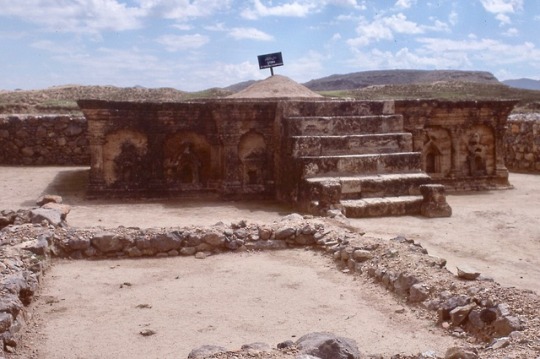
Ruined Stupa, Taxila, Pakistan, 1978.
The ruins of Taxila are, to use a very bad pun, taxing to examine. The ancient city has so many historic roots as to make a lifetime of work just unbraiding them. The city was founded long before Alexander the Great conquered it when it was a major center of Buddhism. It was conquered by various other groups before becoming a ruin in the Islamic theocracy of Pakistan. The Stupa dates from the Buddhist period of its long history.
20 notes
·
View notes
Text
What did the ancient Greeks think of Buddhism? And are there any Buddhist monastic monks who are Greek themselves?

Before writing this paragraph essay, I just wanted to clarify myself first and gave props to my lovely Greek friend, @alatismeni-theitsa for letting me find and explore this part of the hidden histories of the Ancient Greek world. As a Southeast Asian who grew up in a society that was deeply ingrained by Buddhist philosophical teachings and traditional practices from the beginning of 1st-2nd century CE, I often have a lot of conflicting and contradictory thoughts/ ideas of how the society of Ancient Greco-Roman viewed upon Buddhism, and how cool it would be if the Greek settlers in one of those areas emigrated it into their own Western cultural practices and traditions.
Though I find it’s impossible to give a full and totally-reliable answer for all of the Ancient Greeks who lived in the Hellenistic Empire after the Alexandrian conquest, through some archeological and historical research, I will relate what I know on the answer both lie on the sides: “yes” and “no”. (As the reading sources will be listed down below, as usual.)
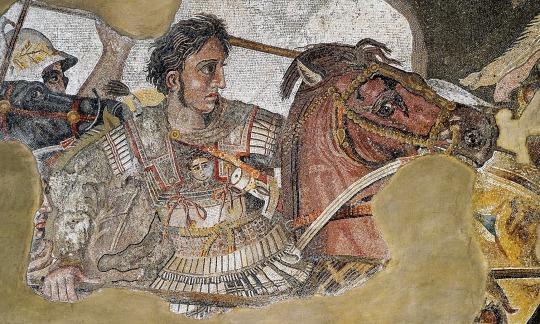
- It is a “yes” because the Greeks’ interaction with the natives of the Indian subcontinent can be considered as the first contact between the Greek culture of the West and Buddhism of the East, and that many Greek conquerers established their cities and kingdoms in the regions of Bactria and northern India, where Buddhism was already thriving. Historically, it was Cyrus the Great (558-530 BCE) who first built the universal empire, stretched from mainland Greece to Indus River, and founded the Achaemenid dynasty of Persia. Since the Persians had been slackened on holding onto its Indian regions into its tight control, many small local, independent kingdoms began to arose in 380 BCE. In 327 BCE, Alexander the Great overran the Persian Empire against Darius I and located his own political entities within these territories, as he would later fight against numerous Indian monarchs in the Punjab region, South Asia during that time too. (The name Punjab literally meant as “the land of five rivers” in Persian.) The furthest Eastern point of his Hellenistic Empire was in the Indo-Greek city of Taxila, now located in modern-day Pakistan; as Alexander himself was exhausted and frightened by the prospect of facing another giant Indian army at the Ganges River. (This might have inspired the story of “Dionysiaca” by Nonnus, where Zeus orders Dionysus to wage on a fighting conquest against the Indians, in order to earn his own title of godhood. And on the other hand, the Greeks were mentioned as “Yavanas” or “Yonas” - a Sanskritized version of the name “Ionia”- in the classical Indian texts - such as “Yuga Parana” and the “Mahabharata”, and other Buddhist texts as well.)
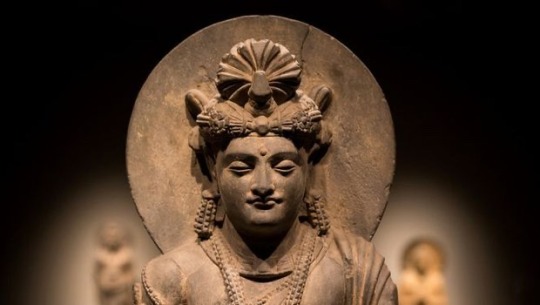
- It is a “yes” because from this previously-mentioned cultural interaction, emerges the artistic manifestation movement of Greco-Buddhism; where the first anthropomorphic depiction of the Buddha begins to appear, often have a youthful Apollo-like face, his eyelids were half-closed and often wearing Roman toga-like garments. (that were common in the Imperial Greek and the later Roman statues.) Previous images of the Buddha were often aniconic - consisted of his foot markings, the bodhi tree, the lotus, and the wheel of dharma - symbolizing the cycle of life. Scenes of Greek mythologies that involved deities such as Zeus, Poseidon, Heracles, Athena, and Aphrodite, etc. were still a common display in these Indo-Greek cities, as well, and they are sometimes incorporated as “smaller deities/divinities” and “protectors” within the Buddhist iconography.
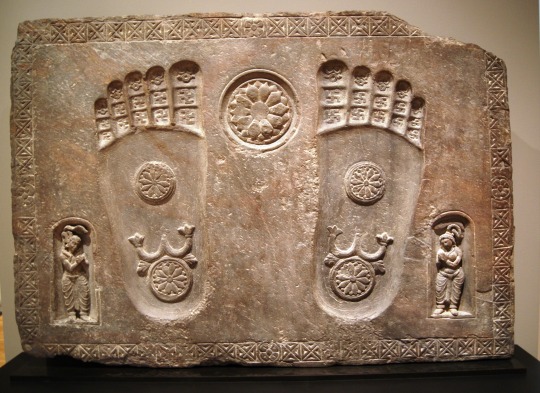

The region of this flourishing culture and artistic style was known by the name “Gandhara”, located in the north of the Kabul river, Afghanistan and up to the valley of Peshawar, Pakistan; and it might possible that Buddhism in this area was once filled with the Greek and Achaemenid Persian conversions. (So yes, Greek Buddhist monastic monks did exist! And that they did practice and participated in Buddhism!) Gandhara was later conquered by numerous nomadic tribes (the Huns and Mongols), then the Hindus, and finally Muslim Sassanid Caliphates (aided by the Turks); lead to the destruction of many historic Buddhist sites, forced cultural assimilation and religious convergence to Islam in many regions of Afghanistan, Pakistan and northern India. One of the most recent destruction of these ancient Buddhist sites can be seen through the destruction of Bamiyan Buddhas by the local Afghan extremist group, the Taliban in 2001.
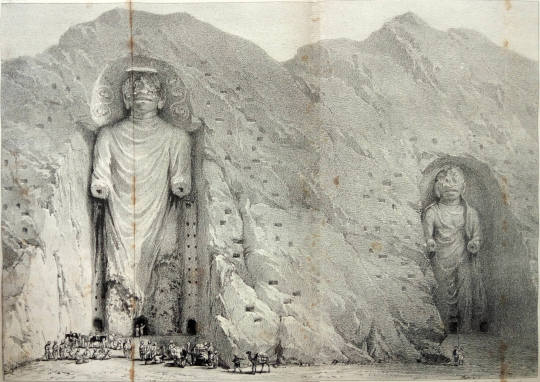
- It is a “yes” because Buddhism might have influenced back at several Greek schools of philosophies and might have played some parts in the later Christian theologies as well. (Albeit are very, very heatedly-debated and controversial !) Many Greek philosophers who have accompanied Alexander in his Eastern campaigns, such as Pyrrho of Elis have opened their own schools that dealt with skepticism and cynicism based on the philosophical teachings of Buddha. And many Christian authors such as St. Clement of Alexandria and St. Jerome are aware of the tales of Buddha and sometimes mentioned them in their own scripts as well, as “he was the one born from the side of the virgin”, with the stories of non-canonized Christian saints “Barlaam and Josaphat” might have been based on the story of his personal life, too.
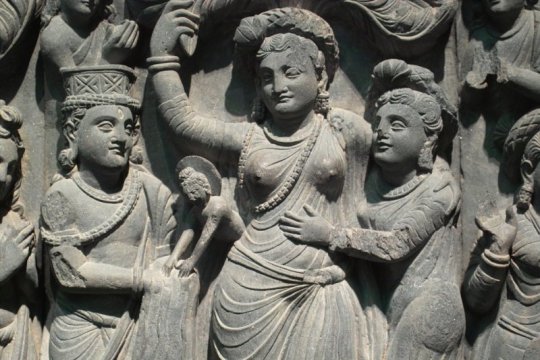
- However, it is a “no” because as a Buddhist myself, unlike the common pagan religions of the West; Buddhism is not really a central authoritative religion that was lead by a holy being/ divinity, even though it’s kind of look like one. But it was not about the idea of total rejection of worshipping one’s own pantheon of gods, either. Buddhism is rather about the spreading of philosophical teachings/ideas of Siddhārta Gautama himself, on how to guide your own life, and to alleviate one’s own sufferings (without the help of any divinity) and the construction of burial mounds known as “stupas” - where it contained Buddha’s sacred relics and his Bodhisattvas, as it was also used as a meditating place for monks as well. (Even though there are some parts of Greek influence in the arts of stupa construction, and there are some contradictory sources that cited “the construction of stupas” originally came from the wider traditions of the Ancient Mediterranean and the Indus Valley. Since it is now also considered as “a prominent part of India's cultural heritage”, so I guess it is kind of a 50/50 ? Both yes and no ?)

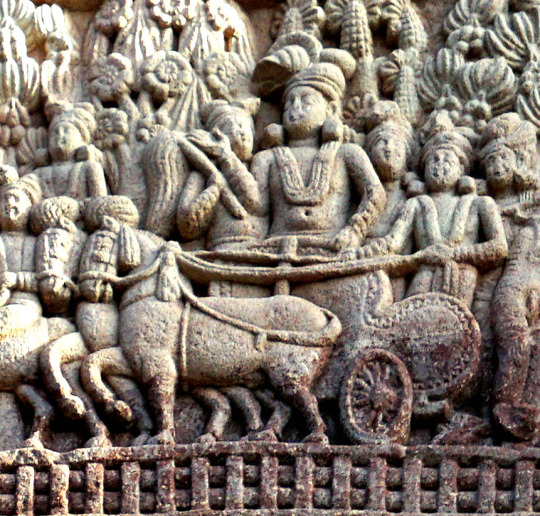
- It is also a “no” because around the time of King Ashoka’s reign - who had been known to adopt Buddhism as “his main state religion and renounce violence/ brutality from the Kalinga war” and responsible for the openings of many Buddhist monasteries in every four points of the compass - Buddhism are just only two centuries old and it was still preferably new, in comparison with the old, ancient pagan Greek gods of the West and that the historical Buddha himself- Siddharta Gautama lived from 480 - 400 BCE, in the area of Lumbini, now located in the modern-day India-Nepal border. However, that does not mean the spreading of Buddhism is impossible, as this new philosophical teachings of Buddhism might perhaps had been popular to the Greeks royals who lived upon the eastern fringes of Seleucid Empire; but haven’t reached out to all of the Greeks who lived in other parts of the Mediterranean area yet. (As Ashoka’s grandmother was alleged to be the daughter of Seleucus I Nicator, and wife of Chandragupta Maurya. And that intermarriages between these two Indo-Greek kingdoms for reasons of “peace treaties” and “political alignments” are quite common around this time, along with the sending and receiving of aphrodisiac gifts.) And even though these areas later broke down into smaller independent Indo-Greek city-states/kingdoms (180 BC- 10 AD) and the Parthian Empire (247 BC-224 AD), the religious practices of Buddhism are still flourished within them.

- It is a “no” because there are a lot of internal socio-political problems that happened in the region of Levant, ruled by Seleucid and Ptolemaic Empire (now known to be located in the modern-day Syria and the Israel-Palestine border) after the 1st century BC- which might make the teachings of Buddhism unable spread further into the West. This can be range from the ongoing competition and conflict of these two empires, the continuing cultural exclusiveness of the local Jewish population to the Hellenization of Greco-Roman cultural and philosophical ideas, the hostility of foreign conquerors from all directions (especially from the Parthians and Armenians), and the slow rise of Christianity - who soon to be dominating all parts of Europe, after the eventual fall of future Rome. The Seleucid Empire finally was overthrown by the efforts of the Roman general, Pompey the Great and the Armenian king Tigranes the Great from 83BC- 63 BC, finally turning them into the small Roman province of Syria. What Seleucid I’s grand vision of a vast, multi-cultural empire living together in peace had now been lost and reduced to nothing, with its ancient historical monuments are now being continously looted and destroyed from future civilizations. (The latest event that happened here was the destruction of Palmyra and Hatra from ISIS in 2014.) And about the previously-mentioned “Jewish resistance of Greco-Roman Hellenization”, it was when the Jewish traditional customs of “Sabbath” and “circumcision” were been officially outlawed by Antiochus IV Epiphanes, and when the Judeo-Christian god being equated with the Olympian Zeus and sacrifices of pigs were made at the Temple of Jerusalem; that led to the outrageous Maccabean revolt in 167–160 BCE, and the celebration of modern-day Hanukkah festival in remembrance.
Because of all of this, the Buddhist culture began to travel to many places of the Far East through the caravan and seafaring routes of Silk Road; and through huge modifications and cultural syncretism, it’s become the East Asian image of the Buddha that we often saw today. (The “cultural syncretism” can be included their own local/regional folk religions and philosophical beliefs (such as the beliefs of Confucianism, Zen) creating new pantheons of buddhas, bodhisattvas, and semi-divine deities.)
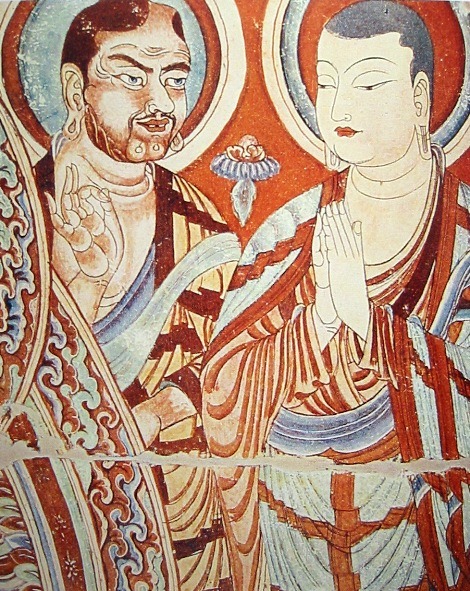
TL/DR: The Greeks, after the Alexandrian conquest, did influence a lot of parts in Indian culture, thanks to a complex chain of social, cultural and political factors. Some of these influences are still persisting within Greece and India to this day. And yes, there are a lot of cultural interactions between the Greek of the West and the Buddhism of the East; and that there are Buddhist monks who are Ancient Greek themselves, too.
+ Sources:
The Crash Course introductory video about Buddhism
Bettany Hughes’ introductory documentary video about Seven Wonders of Buddhism, even though she only just tap a small parts of Greco-Buddhism (For anyone who haven’t introduced or didn’t know about the concepts of Buddhism such as karma, dharma, nirvana, samsara, please watch this.)
The Khan Academy article about the destruction of Afghanistan’s Bamiyan Buddha statues, and the Greco-Buddhism culture once stood there.
The cultural links between India and the Greco-Roman world from Ancient Encyclopedia
The history of Seleucid Empire, during and after the conquest of Alexander the Great from Ancient Encyclopedia.
The debatable/controversial legacy of Buddhism to the Ancient Greek culture, philosophy and the Christian theology (Since I am a Buddhist myself for my whole life, I don’t really know much about other religions such as Christianity. So I let the Wikipedia article to speak for itself, even though it is not always 100% trustable.)
#not really Greek mythology related#but rather about Greek history and culture instead#greco buddhism#silk road related#Ancient Greece#ancient south asia#ancient India#seleucid empire is so hard and so complex#gandhara#bamiyan buddhas#Greek Buddhist monks#pakistan#afghanistan#archeology#ancient art
24 notes
·
View notes
Photo
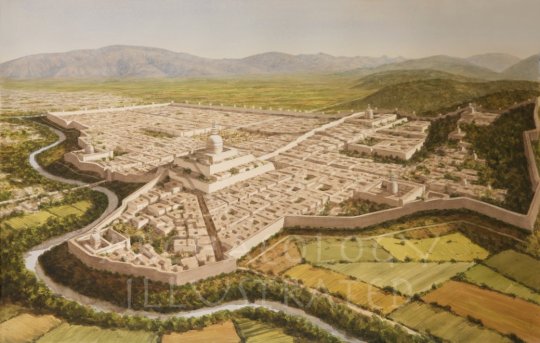
Taxila at Gandhara region, image by Archeology Illustrared
46 notes
·
View notes
Text
Ancient history of India
Alexander's Invasion
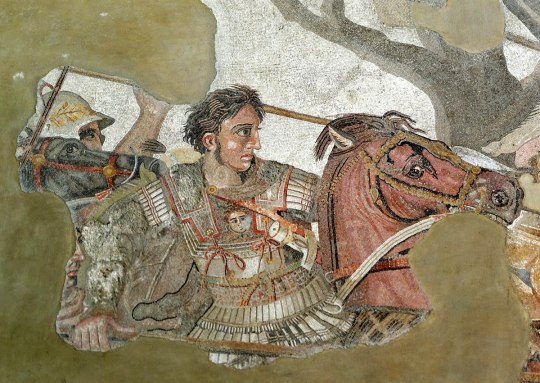
In 326 BC, Alexander invaded India, after crossing the river Indus he advanced towards Taxila. He then challenged king Porus , ruler of the kingdom between the rivers Jhelum and Chenab. The Indians were defeated in the fierce battle, even though they fought with elephants, which the Macedonians had never before seen. Alexander captured Porus and, like the other local rulers he had defeated, allowed him to continue to govern his territory.
During this trip to rivers Hydaspes and Indus in the south, Alexander sought out the Indian philosophers, the Brahmins, who were famous for their wisdom, and debated with them on philosophical issues. He became legendary for centuries in India for being both, a wise philosopher and a fearless conqueror.
One of the villages in which the army halted belonged to the Mallis, who were said to be one of the most warlike of the Indian tribes. Alexander was wounded several times in this attack, most seriously when an arrow pierced his breastplate and his ribcage. The Macedonian officers rescued him in a narrow escape from the village.
Alexander and his army reached the mouth of the Indus in July 325 BC, and turned westward for home.
The Mauryan Empire

The period of the Mauryan Empire (322 BC-185 BC) marked a new epoch in the history of India. It is said to be a period when chronology became definite. It was a period when politics, art, trade and commerce elevated India to a glorious height. It was a period of unification of the territories which lay as fragmented kingdoms. Moreover, Indian contact with the outside world was established effectively during this period.
The confusion following the death of Alexander gave Chandragupta Maurya an opportunity to liberate the countries from the yoke of the Greeks, and thus occupy the provinces of Punjab and Sindh. He later overthrew the power of Nandas at Magadha with the aid of Kautilya, and founded a glorious Mauryan empire in 322 BC. Chandragupta, who ruled from 324 to 301 BC, thus, earned the title of liberator and the first emperor of Bharata.
At a higher age, Chandragupta got interested in religion and left his throne to his son Bindusar in 301 BC. Bindusar conquered the Highland of Deccan during his reign of 28 years and gave his throne to his son Ashoka in 273 BC. Ashoka emerged not only as the most famous king of the Maurya dynasty, but is also regarded as one of the greatest king of India and the world.
His empire covered the whole territory from Hindu Kush to Bengal and extended over Afghanistan, Baluchistan and the whole of India with the exception of a small area in the farthest south. The valleys of Nepal and Kashmir were also included in his empire.
The most important event of Ashoka's reign was the conquest of Kalinga (modern Odisha) which proved to be the turning point of his life. The Kalinga war witnessed terrible manslaughter and destruction. The sufferings and atrocities of the battlefield lacerated the heart of Ashoka. He made a resolve not to wage war any more. He realised the wickedness of worldly conquest and the beauty of moral and spiritual triumph. He was drawn to the teachings of Buddha and devoted his life to the conquest of men's heart by the law of duty or piety. He evolved a policy of Dharma Vijaya, 'Conquest by Piety'.
End of the Mauryan Empire
Ashoka was succeeded by weak rulers, which encouraged the provinces to proclaim their independence. The arduous task of administering such a vast empire could not be executed by the weak rulers. The mutual quarrel among the successors also contributed to the decline of the Mauryan Empire.
In the beginning of the 1st century A.D., the Kushanas established their authority over the north-west frontier of India. The most famous among the Kushana kings was Kanishka (125 A.D.-162 A.D.), who was the third in the Kushana dynasty. The Kushana rule continued till the middle of 3rd century A.D. The most notable achievement of their rule was the development of Gandhara School of Art and further spread of Buddhism into distant regions of Asia.
#history of india#india#history#maruya#alexander the great#ancient india#ancient history#ancient#ashoka#kalinga#chandragupta
4 notes
·
View notes
Photo
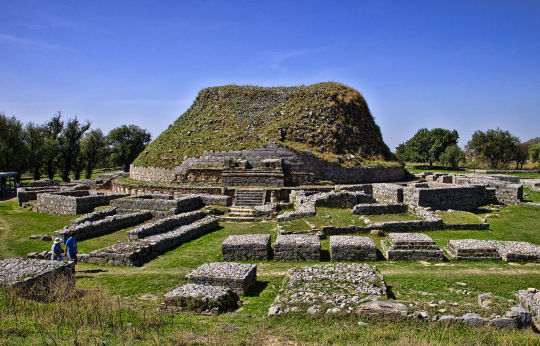
The Dharmarajika Stupa, Taxila, Pakistan.
Dharmarajika Stupa is the earliest Buddhist monument in Pakistan. It was one of eight shrines constructed in the 3rd century B.C. during the reign of Emperor Asoka of the Mauryan dynasty to house relics of the Buddha. Over time the shrine was continually expanded, reaching its largest size in the 2nd century A.D. Now a ruin, the stupa was once coated with lime plaster and gilding, though these have fallen away along with a seven-tier umbrella stone that once crowned the top.
(Source)
#pakistan#punjab#taxila#Dharmarajika#stupa#buddhism#Architecture#art#history#Emperor Asoka#Mauryan dynasty#travel#explore#tourism#iheartpakistan
26 notes
·
View notes
Text
10 ancient universities of India
Vedic India is considered a very important place in the field of education since yesterday. Between the 8th century and the 12th century, India was the largest and famous center of education in the whole world. Where we see that the journey of education started through Gurukul and Ashrams and has reached the universities today. In which today, along with the latest education, importance is given to ancient education, culture, bed, Purana. As time progressed after the Vedic period. The education system of India became equally developed. Many ancient educational institutions like Nalanda University, Taxila University, Vikramshila University were established in India since ancient times. Where students from different countries have achieved the distinction of getting education in these ancient universities.
But today we and most of the people only know Jadya about Nalanda and other Taxila University. But do you know that apart from these ancient universities, there were many other universities and monuments which were temples of education at that time. So let us know about top 10 ancient universities of India here today -
Nalanda university
Taxila University
Vikramashila University Bihar
Pushpagiri University Odisha
Ratnagiri University, Odisha
Vallabhi University Gujarat
Udant Puri University Bihar
Sompura University, Bangladesh
Bikrampur University, Bangladesh
Jagaddal University Bangladesh
1. Nalanda University
Nalanda University is one of the oldest and most prominent centers of education in India. Also known as Nalanda International University. It is an international and research-intensive section located in the historic city of Vihar, India. Nalanda University was an important center of learning of the ancient which functioned primarily as an institution between the 5th and 13th centuries. And shortly thereafter, the Nalanda University began to be transformed into ruins. And the idea of reviving Nalanda University was endorsed at the East Asia Summit in 2007. And on 1 September 2014, Nalanda University started its first academic session.
The university's first chancellor was Nobel Laureate Amartya Sen, followed by former Singapore Foreign Minister George Yeo. Nalanda is a graduate school in particular, currently offering only master's courses, with PhD programs starting in sequential phases from 2020.
2. Taxila University
Taxila University located in Rawalpindi district of Punjab province of Pakistan is one of the most famous educational institutions of ancient times. According to the researchers, Takshila University is believed to have been established about 2700 years ago. And this university had more than 10,000 students from China, Babylon, Syria and Greece along with Indian students. Taxila University was particularly famous for science, medicine and the arts, but it also taught both religious and secular subjects. And even students from different parts of India for studying subjects like archery and astrology. Used to come
The role of Taxila University as a center of knowledge continued under the Mauryan Empire and Greek rule (Indo-Greeks) until the second and third centuries BCE. But the destruction of the Torman in the 5th century AD put a halt to the university's activities.
3. Vikramshila University Bihar
Vikramashila University, built during the reign of King Dharma Pal of the Pala dynasty, was the second most prominent learning center after Nalanda University. Which is currently located in the city of Bhagalpur in Bihar. Vikramashila University was one of the largest Buddhist universities in ancient India and was also a major center of Buddhism in the Indian subcontinent. And this university was known for studying Buddhism, scripture and Vedas. According to historians, Vikramshila University served as India's premier education center from the 8th century to the end of the 12th century.
4. Pushpagiri University Odisha
Pushpagiri University located in Jajpur district of Odisha was established by the Kalinga kings in the third century. And it was one of the oldest universities in India after Nalanda, Tashakshila and Vikramashila University. Which served as a university until the 11th century. The Pushpagiri University has also been transformed into an ancient Buddhist stupa, an important Buddhist site ruins like the ancient Mahavihara.
5. Ratnagiri University, Odisha
Ratnagiri University is an integral part of Buddhist tourist destinations along with Lalitgiri and other Buddhist sites located in the Udayagiri region. It was an important place for pilgrimage and is a major stronghold of Buddhism in Bengal in Odisha and in Northeast India. Udayagiri and Lalitgiri are two large Buddhist complexes in the state of Odisha. Which is a part of Puspagiri University, known as the Diamond Triangle of Odisha. Excavations conducted by the Archaeological Survey of India show that it was a large Buddhist complex. There were statues of Buddha, stone wells and many terracotta temples.
6. Vallabhi University Gujarat
Vallabhi University was an important center of Buddhist education, located in Bhavnagar district of Gujarat. The university was also famous for Buddhist education as well as education for secular subjects. This was the reason that students from all over the world used to come to Vallabhi University to get education. And this university had gained prominence in the field of education mainly from the 6th century to the 12th century for about 600 years. And it was also considered a rival of the ancient university Nalanda.
7. Udanta Puri University Bihar
Udanta Puri University is one of the oldest universities in India. Udanta Puri University was built during the reign of Pal Bansh. According to historians, the University of Udanta Puri served as an important center of education from the 8th century to the 12th century. And about 12000 students were educated in this university.
. Sompura University, Bangladesh
Sompura University in Naugaon district of Bangladesh is one of the most important Buddhist viharas in the Indian subcontinent. Which was the best teaching center of Buddhism in ancient times. Which was also founded by the kings of the Pala dynasty. It hosted a traditional Buddhist stupa at the center. And it was the largest of the monasteries, spread over about 27 acres.
9. Bikrampur University, Bangladesh
Bikrampur Vihar located in Bangladesh was the most famous vihara of ancient India, which is today part of Munshiganj district. Bikrampur University was a major center of ancient Buddhist education during the Pura Empire.
10. Jagaddal University Bangladesh
Jagaddal University was primarily a Buddhist monastery. Which is currently located in North Bengal, Bangladesh. And the credit of its establishment also goes to the rulers of the Pala dynasty, who built it. Jagaddal Mahavihara is listed as a temporary site for UNESCO World Heritage Sites and Jagaddal University is one of the five great monuments of India including Vikramashila, Nalanda, Sompura and Odantapura.
#ancient universities of India#icse kolkata schools admissions#Udanta Puri University Bihar#Taxila University#best isc school kolkata
0 notes